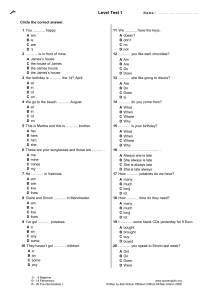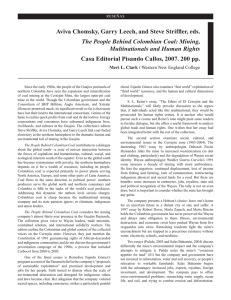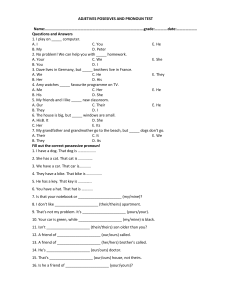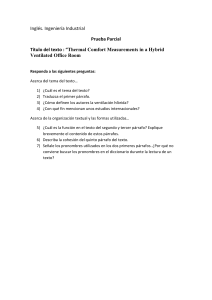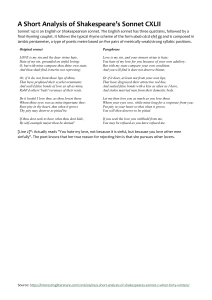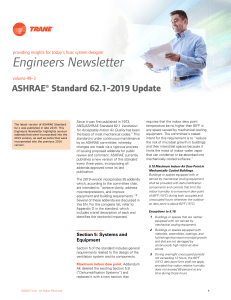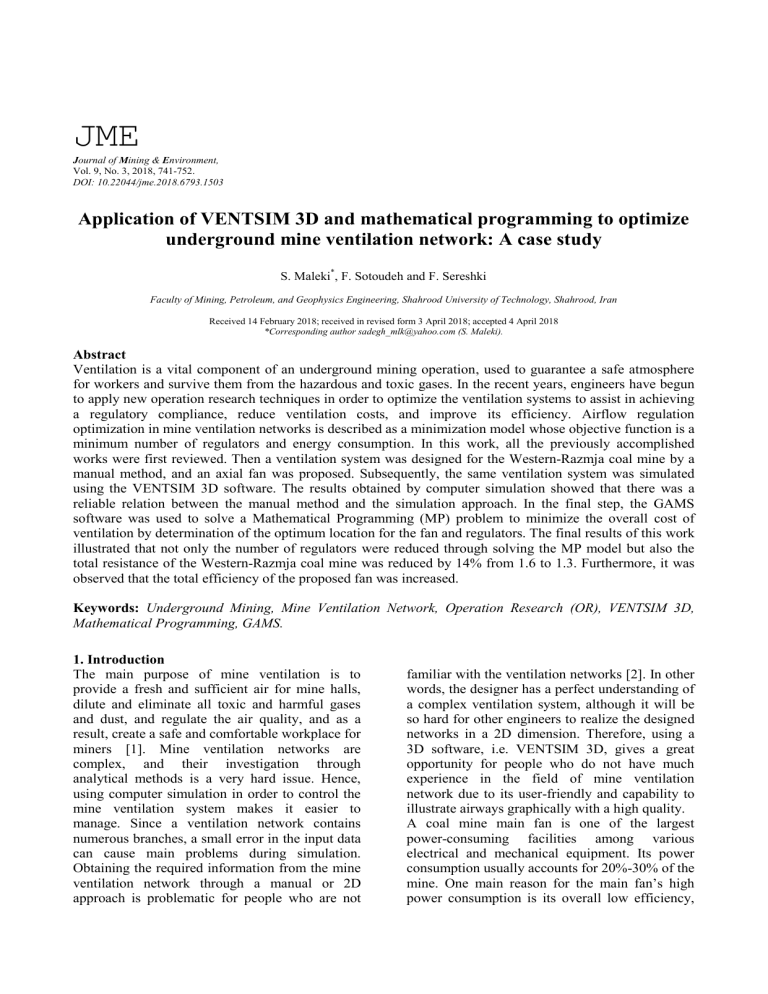
JME Journal of Mining & Environment, Vol. 9, No. 3, 2018, 741-752. DOI: 10.22044/jme.2018.6793.1503 Application of VENTSIM 3D and mathematical programming to optimize underground mine ventilation network: A case study S. Maleki*, F. Sotoudeh and F. Sereshki Faculty of Mining, Petroleum, and Geophysics Engineering, Shahrood University of Technology, Shahrood, Iran Received 14 February 2018; received in revised form 3 April 2018; accepted 4 April 2018 *Corresponding author [email protected] (S. Maleki). Abstract Ventilation is a vital component of an underground mining operation, used to guarantee a safe atmosphere for workers and survive them from the hazardous and toxic gases. In the recent years, engineers have begun to apply new operation research techniques in order to optimize the ventilation systems to assist in achieving a regulatory compliance, reduce ventilation costs, and improve its efficiency. Airflow regulation optimization in mine ventilation networks is described as a minimization model whose objective function is a minimum number of regulators and energy consumption. In this work, all the previously accomplished works were first reviewed. Then a ventilation system was designed for the Western-Razmja coal mine by a manual method, and an axial fan was proposed. Subsequently, the same ventilation system was simulated using the VENTSIM 3D software. The results obtained by computer simulation showed that there was a reliable relation between the manual method and the simulation approach. In the final step, the GAMS software was used to solve a Mathematical Programming (MP) problem to minimize the overall cost of ventilation by determination of the optimum location for the fan and regulators. The final results of this work illustrated that not only the number of regulators were reduced through solving the MP model but also the total resistance of the Western-Razmja coal mine was reduced by 14% from 1.6 to 1.3. Furthermore, it was observed that the total efficiency of the proposed fan was increased. Keywords: Underground Mining, Mine Ventilation Network, Operation Research (OR), VENTSIM 3D, Mathematical Programming, GAMS. 1. Introduction The main purpose of mine ventilation is to provide a fresh and sufficient air for mine halls, dilute and eliminate all toxic and harmful gases and dust, and regulate the air quality, and as a result, create a safe and comfortable workplace for miners [1]. Mine ventilation networks are complex, and their investigation through analytical methods is a very hard issue. Hence, using computer simulation in order to control the mine ventilation system makes it easier to manage. Since a ventilation network contains numerous branches, a small error in the input data can cause main problems during simulation. Obtaining the required information from the mine ventilation network through a manual or 2D approach is problematic for people who are not familiar with the ventilation networks [2]. In other words, the designer has a perfect understanding of a complex ventilation system, although it will be so hard for other engineers to realize the designed networks in a 2D dimension. Therefore, using a 3D software, i.e. VENTSIM 3D, gives a great opportunity for people who do not have much experience in the field of mine ventilation network due to its user-friendly and capability to illustrate airways graphically with a high quality. A coal mine main fan is one of the largest power-consuming facilities among various electrical and mechanical equipment. Its power consumption usually accounts for 20%-30% of the mine. One main reason for the main fan’s high power consumption is its overall low efficiency, Maleki et al./ Journal of Mining & Environment, Vol. 9, No. 3, 2018 so the principal optimization problem associated with underground mine ventilation systems is to determine the number, location, and duty of the fans and regulators to deliver the required airflow and pressure distribution at the lowest fan power or energy consumption [3]. In this work, after simulation of the Western-Razmja coal mine, one of the Eastern Alborz coal mine Companies, a mathematical programming problem related to the ventilation network was used to optimize and determine the best locations for the fan and regulators. In what follows, a review of the previously research works regarding the mine ventilation design and optimization is presented. independent variables for the air pressure and air flow. This method leads the system to allocate the ventilation equipment such as fans and regulators. Jacques [8] has introduced a heuristic algorithm with an objective function based on minimizing the airflow deviation rather than air power minimization. Although this method was unable to locate the required fans and regulators, it could determine the distribution of airflow considering the Kirchhoff’s second law. Huang and Wang [9] have proposed a new optimization method based on Generated Reduced Gradient (GRG), which minimizes the total air power by applying two steps: 1) determination of search direction 2) calculation of the fan and regulator pressures. They implemented their model on a ventilation system consisting of 9 nodes and 18 branches. Kumar et al. [10] have presented an algorithm consisting of two main approaches. In the first approach, they determined the best performance and location of the main fans using CPM to establish the largest pressure drop of the ventilation network. In the second approach, identification of the pressure for underground booster fans was carried out using a heuristic algorithm including Fibonacci and the cyclic search method. Wu and Topuz [11] have developed a new algorithm based on the mathematical programming, branch, and bound technique. Due to the fact that their model followed a non-linear programming model, they transformed the algorithm to a linear programming problem. The final results of their proposed model illustrated that it was able to determine the required airflow distribution. Lowndes and Yang [12] and Lowndes et al. [13] have developed a new Genetic Algorithm (GA) based on the search method in order to find out the location and pressure of the booster fans in underground mines. Their optimization model was implemented on the Chilean El Indio mine. The results of their implementation showed that the algorithm was able to perform an optimum solution with 3 of 16 underground booster fans. Li Jiang et al. [14] have established a non-linear mathematical programming with the objective of minimizing the energy consumption in a simple ventilation system. The results of this study demonstrated that it had a 3% decreasing rate. Zhao Dan et al. [15] have introduced a new heuristic algorithm named Powell. An integration of this algorithm was carried out into a GA to produce a Hybrid Genetic Algorithm (HGA) in order to optimize the ventilation network. The objective function was minimizing the costs. After 2. Literature review 2.1. Mine ventilation design With the development of computer techniques in mining industry, the design of ventilation networks for underground mines by computers has served as a reliable way. In other words, application of computers such as VENTSIM is a good alternative to the experimental and manual methods due to their simplicity and accuracy. Table 1 presents a summary of the previous research works on the mine ventilation system design. 2.2. Mine ventilation optimization In the recent years, several research works have been accomplished regarding mine ventilation optimization. Calizaya et al. [4] have used a hybrid solution method to study mine ventilation optimization. Their method applies a set of linear calculations to the branch resistance, and as a result, a minimum fan power is measured by this linear technique and the regulator resistance curves. Barnes [5] has developed a new algorithm based on non-linear programming in order to seek an improvement solution for airflow distribution and evaluation of pressure. The algorithm establishes a set of possible flows and improves the flows while maintaining feasibility. Wu and Topuz [6] have developed a new model to distribute the airflow considering a minimum power consumption. They solved their optimization model in three separate classes including the linear programming method (Simplex Method), Critical Path Method (CPM), and application of the CPM and cut-set techniques. Wang [7] has utilized the NewtonRaphson iterative method to optimize the ventilation system. The methodology of this algorithm is based upon a specific routine by dividing the main problem into dependent and 742 Maleki et al./ Journal of Mining & Environment, Vol. 9, No. 3, 2018 implementation of a ventilation network, they found that HGA was able to remove the main GA drawbacks. GYWCY Jichao [16] have presented the particle swarm algorithm to minimize the overall energy consumption considering the balance conditions for air quantity and pressure. They examined their model on an example of mine ventilation network and showed that the performance of their model was very high compared to the other intelligent optimization models. Table 2 shows a summary of the previously accomplished works on mine ventilation optimization. 4.1. Air flow In the first step, According to the characteristics of the Western-Razmja coal mine, the essential parameters consisting of the number of workers in stopes, coal seam radiation, blasting operations, and the minimum air speed are utilized for stopes, which are under preparation and extraction conditions [52]. Tables 3 and 4 show the measured values for airflow in the stopes under preparation and extraction, respectively. Figure 2 illustrates the airflow distribution for the entire ventilation network. 4.2. Fan and regulator selection In order to regulate the pressure drop in the ventilation network, it is necessary to identify the direction and value of airflow in every branch. For this reason, each node should have the same input and output airflow. After that, it can be interpreted into meshes and critical paths. In this work, using the manual method and considering the fact that the pressure drop should be equal to zero in each mesh (Equation 1), locations of the fans and regulators were determined through ensuing conditions [53]: 1: if the pressure drop is greater than zero (∑±ΔΡi > 0), it is required to locate regulator in the negative direction or fan in the positive direction. 2: if the pressure drop is equal to zero (∑±ΔΡi = 0), it is not required to locate any regulator or fan in any branch. 3: if the pressure drop is lower than zero (∑±ΔΡi < 0), it is required to locate fan in the negative direction or regulator in the positive direction. 3. Case study The Western-Razmja coal mine, one of the main mines in Eastern Alborz Coal Mines Company, is selected as a case study for this research work. This mine is located 80 km from the city of Shahrood in Alborz Mountains (Figure 1). Longwall mining was applied for this mine in order to extract coal from the K5, K8, K13, and K19 seams. According to the exploration reports, the host rocks of this mine are related to the upper Triassic and lower Jurassic periods [51]. The Western-Razmja coal mine ventilation has been performed by natural ventilation and several booster fans. However, with the development and expansion of the network, it is required to establish an appropriate ventilation design, which is discussed in this study. i n i n i 1 i 1 Pi R i Qi2 (1) Based upon these conditions, 1 fan and 10 regulators are located in the Western-Razmja mine ventilation network, which are shown in Figure 3. The calculations results show that the approximate diameter of the fan is equal to 1.459 m and the resistance of the interior equipment is equal to 0.074 Kmorg. Furthermore, the main fan should satisfy 19.57 (m3/s) for airflow and 81.65 (mmH2O) in pressure. Considering the characteristics of Russian fans which are commonl used in ranian coal mines a s ecial a ial fan t e O with blade angle is performed for this ventilation network. The main specifications of this fan are shown in Table 5. Figure 1. Western-Razmja coal mine location. 4. Manual design The design of air conditioning for underground mines is based upon several principals including preparation of mine maps, identification of mine branches and ventilation nodes, calculation of resistance and airflow for each branch, measurement of pressure drop for each branch of a grid, network adjustment, and selection of the main fan and regulators. 743 Maleki et al./ Journal of Mining & Environment, Vol. 9, No. 3, 2018 Table 1. A summary of previous research works related to mine ventilation design. Year 2001 2002 2003 2006 2008 2011 2012 2013 Author Widzyk-Capehart and Watson [17] Widzyk-Capehart and Fawcett [18] Madani and Osgoui [19] Marx and Belle [20] Gashtasbi et al. [21] Madani and Mofti [22] Design Method Software Manual 2D 3D ● ● ● ● ● ● ● ● ● ● ● ● Exikis and Kapageridis [23] Madani et al. [24] Anemangoli et al. [25] Wei et al. [26] Gusat et al. [27] Lilic et al. [28] suvar et al. [29] Chaoqun [30] Ghazvivni and Aghjani [31] Elahi zeini and Rabiei nejhad [32] Elahi zeini and Rabiei nejhad [33] Felsner [34] Pazin fushazde [35] Akande and Moshood [36] Stewart [37] ● ● ● ● ● ● 2015 2016 Cioclea et al. [39] Elahi zeini [40] Zariei darmeian et al. [41] Bagher zadeh et al. [42] ● The dilution of harmful gases was applied in Eastern-Kelariz coal mine using artificial ventilation and determination of main fan. ● ● ● ● ● ● ● ● Acunaa and Wallace [43] ● Sethi [44] Zhang and SUO [46] ● ● Elahi zeini et al. [45] ● The primary design of ventilation system was studied during the preparation step in Galanderoud mine. Simulation of a coal mine was carried out using VUMA by the trial-and-error approach to optimize the ventilation system. The ventilation system in Razi coal mine was designed, and finally, measured values were validated using Tahvie. Due to the expansion of Kiasar coal mine and existence of main problems, the ventilation system was investigated carefully. The ventilation network of an underground mine was simulated in a computer and the location of fans was determined under emergency conditions. Due to several problems in the Heshuni mine ventilation system, the re-design and evaluation of effective parameters were investigated. In this study, the eastern Kelariz mine was simulated using VENTSIM. VENTSIM 3D was used to manage the Donghai ventilation system due to its size and complexity. This study presented the main advantages of simulation in mine ventilation networks. Long-term planning for ventilation and optimization process was discussed for the Omerler mine. The problem of complex ventilation networks was investigated using VENTSIM Visual Advanced. Mine ventilation system re-designed in Tongxing mine and the existing problems were discussed to optimize the ventilation network. In this study, a ventilation network was designed using VENTSIM 3D in Eastern-Yourt coal mine. The dilution of harmful gases was applied in the Western-Razmja coal mine using artificial ventilation and determination of main fan. ● ● ● The Bronzewing mine ventilation system simulated and optimized in VENTSIM and long-term planning was investigated. ● Haghighat [38] 2014 Due to the increase in mining depth, the development of ventilation system was studied using VENTSIM. ● ● Description Using VENTSIM, based on the existing condition of Erzberg mine, the ventilation system was designed. The ventilation system for the Anguran underground mine was studied using VENTSIM. The design of Okaba coal mine was carried out using Auto-CAD, and the locations of auxiliary fans were specified. In this study, the ventilation of blasted region was accomplished in an underground mine. In this study, the underground mine ventilation network was analyzed carefully, and the installation of the main and auxiliary fans was determined in VENTSIM. The various effects of harmful gases produced by blasting operations were discussed in underground mines. The manual design of Takht coal mine was investigated, and the intensity of air flow was proposed as well. The design of ventilation network for the Tabas mine was designed during the drilling process. In this study, the design of ventilation system for Tabas Parvadeh Coal Mine was performed. In this study, based on the predicted production rate, the design of ventilation system for Teniente mine was carried out considering the sensitivity analysis. This study examines the amount of pressure and air quality for Nandira coal mine using VENTSIM. In order to overcome the high resistance of Majiagou coal mine, its network was simulated in VENTSIM and analyzed carefully. In this study, the conditions of Tunnel-8 coal mine were simulated in VENTSIM, and the distribution of current was evaluated in the entire system. 744 Maleki et al./ Journal of Mining & Environment, Vol. 9, No. 3, 2018 Table 2. A summary of previous research works related to mine ventilation optimization. Year 1987 1988 1989 1989 1991 1993 1995 1998 2004 2005 2007 2009 2010 2013 2015 2016 2017 Author Calizaya et al. [4] Barnes [5] Wu and Topuz [6] Wang [7] Jacques [8] Huang and Wang [9] Kumar et al. [10] Wu and Topuz [11] Lowndes and Yang [12] Lowndes et al. [13] Li Jiang et al. [14] Zhao Dan et al. [15] Acuña et al. [47] GYWCY Jichao [16] Nyaaba, W et al. [48] Sotoudeh et al. [49] Xu, G et al. [50] Solution Method Gaussian elimination and linear optimization Non-linear programming Linear programming & CPM Newton-Raphson Heuristic GRG CPM & Fibonacci algorithm Branch & Bound–Linear Programming GA GA Non-linear programming HGA GA & ventilation solver Particle swarm algorithm First-order Lagrangian (FOL) algorithm MIP Calibrated non-linear programming Optimality ● ● ● ● ● ● ● ● ● ● ● Table 3. Required airflow in stopes under preparation. Stopes (advancing) K19-west (+2152) K19-west (+2200) K8-west (+2090) No. of workers (m3/min) 18 18 18 Gas Radiation (m3/min) Blasting (m3/min) 50 50 50 161.53 203.09 145.01 Min. air speed (m/min) 90 90 90 Max. air flow (m3/min) 161.53 203.09 145.01 Safety factor Final air flow (m3/s) 1.2 1.2 1.2 3.23 4.06 2.09 Safety factor Final air flow (m3/s) 1.2 1.2 1.2 1.2 1.2 3.36 4.03 4.03 2.61 2.95 Table 4. Required airflow in stopes under extraction. Stopes (advancing) K13-east (+2152 to +2090) K19-west (+2276 to +2200) K19-east (+2200 to +2152) K5-west (+2120 to +2152) K8-west (+2152 to +2090) No. of workers (m3/min) 42 42 42 42 42 Gas Radiation (m3/min) 167.83 201.39 201.39 130.23 147.55 Min. air speed (m/min) 36.45 36.45 36.45 36.45 36.45 Max. air flow (m3/min) 167.83 201.39 201.39 130.23 147.55 Figure 2. Airflow distribution for entire mine ventilation network (m3/s). 745 Maleki et al./ Journal of Mining & Environment, Vol. 9, No. 3, 2018 Table 5. Specifications of selected fan for Western-Razmja coal mine [52]. Fan type (VOD-16) Parameter Value Airflow (m3/s) 12-67 Pressure (mmH2O) 92-438 Speed (RPM) 1000 Diameter (m) 1.6 Power (KW) 40-270 Efficiency (%) 77-79 Figure 3. Locations of fan and regulators in Western-Razmja coal mine. network considering the locations of fans and regulators. After implementation of these parameters, 2000 iterations were carried out to simulate the airflow distribution for the entire branches and stopes (Figure 4). The results obtained from VENTSIM are shown in Table 6. Also a comparison of airflow distribution through the manual method and 3D simulation is illustrated in Table 7. According to this table, it is evident that the simulation results are very analogous to the simulation results. 5. VENTSIM simulation According to the latest network of the Razmja coal mine, the AutoCAD software is used to define the airflow ways entire the branches and stopes using a central line. Then the constructed file, which is in a DXF format, is introduced to VENTSIM as an input file in order to simulate the air ways. Furthermore, several Parameters consisting of the length of branches, cross area, friction factor, etc. are defined for VENTSIM to regulate and simulate the airflow for the entire 746 Maleki et al./ Journal of Mining & Environment, Vol. 9, No. 3, 2018 Figure 4. Airflow distribution in Western-Razmja coal mine (VENTSIM 3D). Table 6. A summary of simulation results obtained from VENTSIM simulation. Network System Summary Natural Ventilation Pressure No Airways 675 Total Length 16950 (m) Total Airflow Intake 20 (m3/s) Total Airflow Exhaust 20 (m3/s) Total Massflow 24 kg/s Mine Resistance (excluding duct) 1.6 Ns2/m8 Mine Resistance (including duct) 1.6 Ns2/m8 Air (friction loss) Power - Total 13 (kW) Air (friction loss) Power - Shaft 1.5 (kW) Air (friction loss) Power - Drive 12 (kW) Table 7. Airflow values for preparation and extraction stopes using VENTSIM simulation. Stopes (advancing) Required Airflow (m3/s) Airflow Simulation (m3/s) Stopes (Extraction) K13-east (+2152 to +2090) 3.36 3.37 K19-west (+2276 to +2200) 4.03 9.2 K19-east (+2200 to +2152) 4.03 7.71 K5-west (+2120 to +2152) 2.61 2.78 K8-west (+2152 to +2090) 2.95 2.99 Stopes (Preparation) K19-west (+2152) 3.23 9.7 K19-west (+2200) 2.09 7.71 K8-west (+2090) 4.04 4.18 must satisfy the Kirchhoff‘s Current Law KCL [11]: the airflow of any node is equal to the flow into that node. The mathematical model of this law can be shown as Equation 2. 6. Mathematical modeling The main goal of optimization in mine ventilation network is determination of the optimum locations for fans and regulators and minimization of overall power costs. As shown in Figures 2 and 3, stopes and airways are represented as lines (branches) and the connected points as nodes in an underground mine ventilation network. Like an electrical network, a mine ventilation network b a Q j 1 ij j 0 i = 1,2,3, ... ,n Or: AQ=0 (2) Where A is a linearly independent matrix of order (n-1) × b and A = aij; the aij values are defines as: 747 Maleki et al./ Journal of Mining & Environment, Vol. 9, No. 3, 2018 1 -1 0 If branch j is connected to node i and the airflow goes away node i If branch j is connected to node i and the airflow goes into node i If branch j is not connected to node i Qj is the airflow quantity through branch j, and b and n are the numbers of branches and nodes in the ventilation network, respectively. In addition, a mine ventilation network should satisfy the Kirchhoff‘s oltage Law K L : the sum of pressure drops around any mesh in the network must be equal to zero [11]. The mathematical model of this law can be shown as Equation 3. 1 -1 0 b b j 1 j 1 ij If branch j is not contained in mesh i a HF C Y j j j j j L j L (R j Q j Q j HR j HFj HN j 0 HF d jY which are representatives of the Western-Razmja ventilation network meshes and branches, is shown in Figure 5. In the next step, the mathematical modeling for this mine is carried out using the formulas mentioned in Section 6 considering 6000 $/power for Cp and 2500 $/power for Cj. The problem was solved using the GAMS software. The results of mathematical modeling show that 4 regulators are removed from the main ventilation networks (branches 20, 31, 41, and 48) and 1 fan is located in branch 11. Furthermore, the total resistance of this mine, measured in Section 5, was reduced by 14%. In other words, its value decreased from 1.6 Ns2/m8 to 1.5 Ns2/m8. Also in addition to minimizing the overall ventilation costs, it is observed that the total efficiency is increased as well. (4) HR 0 , HFj 0 1, Y j 0 7. Discussion The airflow in mine ventilation is realized with the aid of ventilation control devices such as fans and regulators. The optimal determination of location and size of these control equipment is the most important problem in the design and analysis of mine ventilation systems. According to the results obtained from the optimization process through the mathematical model, it can be concluded that the number of regulators have been reduced due to minimization of the mining costs. Simulation of the mathematical model outputs in VENTSIM show that the values for airflows have changed, and it has been able to satisfy the required airflow in the preparation and extraction stopes. Figure 6 shows a brief comparison regarding the total efficiency values into the two i = 1,2,3, ... , L j L j (3) where B is a fundamental mesh matrix, B = bij; the elements bij are defined as: Regarding the Kirchhoff‘s laws investigated before, the constraints of this model can be described as follow: L i = 1,2,3, ... , m Or: BH=0 If branch j is contained in mesh i and has a same direction If branch j is contained in mesh i and has a opposite direction Cpq j a j b Hj 0 H j HL j HR j HFj HN j HLj is the pressure for branch j, R is the resistance factor for branch j, HRj is the pressure drop of the regulator in branch j, HFj is the fan pressure in branch j, and HNj is the natural ventilation pressure across branch j. Consequently, with consideration of Cp for the annual energy cost, Cj for maintenance and purchase cost, dj for the upper bound of HFj, and Yj that is a binary variable, the objective function can be represented as Equation 4: Minimize Z = ij j = 1,2,3, ... , b HFj 0 otherwise 6.1. Real model (Western-Razmja Mine) As described in Section 6, the required matrix (bij) was introduced to identify the sign of pressure drop in the mathematical model. This matrix consisting of 11 rows and 48 columns, 748 Maleki et al./ Journal of Mining & Environment, Vol. 9, No. 3, 2018 manual and mathematical modeling approaches. According to this figure, it can be observed that the fan efficiency is increased from 58% to 65%. Therefore, through the mathematical model and formulation of ventilation network as a mixed integer, programming is a useful way to obtain an optimal solution. 1 2 3 4 5 6 7 8 9 10 11 12 13 14 15 16 17 18 19 20 21 22 23 24 1 0 0 0 0 0 0 0 0 0 0 0 0 0 0 0 0 0 0 0 0 0 0 0 0 2 0 0 0 0 0 0 0 0 0 0 0 0 0 0 0 0 0 0 0 0 0 0 0 0 3 0 0 0 0 0 0 0 0 0 0 0 0 0 0 0 0 0 0 -1 1 1 -1 0 0 4 0 0 0 -1 0 0 0 0 0 0 0 0 0 0 0 0 0 0 0 0 0 0 0 1 5 0 0 -1 0 0 0 0 0 0 0 0 -1 1 1 1 0 0 0 0 0 0 0 0 -1 6 0 1 0 0 0 0 -1 0 0 0 0 1 -1 0 0 0 0 0 0 0 0 0 0 0 7 0 0 -1 -1 -1 0 0 0 0 0 0 -1 1 1 0 0 0 0 0 0 0 0 0 0 8 0 0 0 0 0 -1 0 0 0 0 0 0 0 0 1 1 0 1 1 0 0 1 1 0 9 0 0 0 0 0 0 0 0 0 0 -1 0 -1 -1 -1 -1 0 -1 0 -1 -1 0 -1 0 10 1 1 0 0 0 0 0 0 0 0 1 1 0 0 0 0 0 0 0 0 0 0 0 0 11 1 0 0 0 0 0 1 -1 -1 -1 0 0 0 0 0 0 0 0 0 0 0 0 0 0 25 26 27 28 29 30 31 32 33 34 35 36 37 38 39 40 41 42 43 44 45 46 47 48 1 0 0 0 0 0 0 0 0 0 0 0 0 0 0 0 1 -1 1 0 0 0 0 0 0 2 0 0 0 0 0 0 0 0 0 0 1 -1 0 0 -1 -1 0 0 1 0 0 0 0 0 3 0 0 0 0 0 0 0 0 0 0 0 0 0 0 0 0 0 0 0 0 0 0 0 0 4 0 0 1 1 1 0 0 0 0 0 0 0 0 0 0 0 0 0 0 0 0 0 0 0 5 0 1 0 0 0 0 0 0 0 0 0 0 0 0 0 0 0 0 0 0 0 0 0 0 6 0 0 0 0 0 0 0 0 0 0 0 0 0 0 0 0 0 0 0 0 0 0 0 -1 7 1 0 0 0 0 1 1 0 0 0 0 0 0 0 0 0 0 0 0 0 0 0 0 0 8 -1 0 0 0 0 -1 -1 -1 0 -1 -1 0 0 0 0 0 0 0 0 -1 0 0 0 0 9 0 0 0 0 0 0 0 0 0 0 0 0 0 0 0 0 0 0 0 0 -1 0 0 0 10 0 0 0 0 0 0 0 0 0 0 0 0 0 0 0 0 0 0 0 0 0 0 -1 0 11 0 0 0 0 0 0 0 0 0 0 0 0 0 0 0 0 0 0 0 0 0 -1 0 0 Figure 5. Matrix [bij] for Western-Razmja coal mine. 8. Conclusions This paper presents the application of VENTSIM and a common mathematical programming model in the Western-Razmja coal mine to optimize a defined problem consisting of an objective function, which is minimization of the overall costs and determination of the best location for fans and regulators. In order to reach this goal, the preliminary design was carried out by the manual method, and as a result, 1 fan and 10 regulators were determined considering the values 20 m3/s and 1.6 Ns2/m8 for the airflow and resistance, respectively. In the second step, the results obtained from the manual design were imported to VENTSIM and simulated precisely. The outputs illustrated that the airflow distributed very well and satisfied the required airflow for the entire ventilation network. The main purpose of the simulation was to design the airflow distribution for the entire ventilation network, and the overall costs and optimum locations were not considered in this approach, while the mathematical programming for mine ventilation network was Figure 6. Total efficiency of fan 1: manual method 2: mathematical formulation. 749 Maleki et al./ Journal of Mining & Environment, Vol. 9, No. 3, 2018 able to not only guarantee the optimum location for ventilation equipment but also reduce the operating costs. Therefore, a mathematical model, which satisfies Kirchhoff’s laws was proposed and solved using the GAMS software for the Western-Razmja coal mine. It was concluded that the regulators located in branches 20, 31, 41, and 48 should be removed. Then this modification was applied on VENTSIM and simulated like the first step. The final results illustrated that the total exiting resistance was reduced by 14.37% from 1.6 Ns2/m8 to 1.5 Ns2/m8. Also the total efficiency was increased by eliminating 4 regulators in the ventilation network. Ventilation Symposium, SME, Littleton, Colorado. pp. 411-418. [9]. Huang, C. and Wang, Y.J. (1993). Mineventilation network optimization using the generalized reduced gradient method. SME, Littleton, Colorado (USA). [10]. Kumar, G.V., Sastry, V.R. and Rao, G.V.K. (1995). Minimizing power consumption in multiple fan networks by optimum fan selection, Society for Mining, Metallurgy, and Exploration, Inc., Littleton, Colorado (USA). [11]. Wu, X.S. and Topuz, E. (1998). Analysis of mine ventilation systems using operations research methods. International Transactions in Operational Research. 5 (4): 245-254. Acknowledgment The authors would like to express their gratitude to Chasm Consulting (VENTSIMTM) for the unsparing supports to provide license for the VENTSIM 3D software used in this work. [12]. Lowndes, I.S. and Yang, Z.Y. (2004). The application of GA optimisation methods to the design of practical ventilation systems for multi-level metal mine operations. Mining Technology. 113 (1): 43-58. [13]. Lowndes, I.S., Fogarty, T. and Yang, Z.Y. (2005). The application of genetic algorithms to optimize the performance of a mine ventilation network: the influence of coding method and population size. Soft Computing. 9 (7): 493-506. References [1]. Sereshki, F., Saffari, A. and Elahi, E. (2016). Comparison of Mathematical Approximation Methods for Mine Ventilation Network Analysis. International Journal of Mining Science (IJMS). 2 (1): 1-14. [14]. Li, J., Chen, K.Y. and Lin, B.Q. (2007). Genetic algorithm for the optimization of mine ventilation network. International Journal of Mining Science and Technology. 36 (6): 789. [2]. Wei, L.J., Wang, D.M., Wang, Q. and Ge, P. (2007). Study on some key issues of constructing visual mine ventilation simulation system [J]. Safety in Coal Mines. 7: 001. [15]. Zhao, D., Liu, J., Pan, J.T. and Ma, H. (2009). Hybrid genetic algorithm for the optimization of mine ventilation network. Journal of Coal Science and Engineering. 15 (4): 389. [3]. Wang, Q., Wei, J., Yuan, R. and Zhu, C. (2009). Scheme design of technology improvement for Coal Mine main fan. In Computational Intelligence and Industrial Applications, Asia-Pacific Conference on. (2): 54-57. [16]. Jichao, G.Y.W.C.Y. (2013). Mine ventilation network based on cultural particle swarm optimization algorithm. Journal of Southeast University (Natural Science Edition), S1. [4]. Calizaya, F., McPherson, M.J. and Mousset-Jones, P. (1987). Algorithm for selecting the optimum combination of main and booster fans in underground mines. In Unknown Host Publication Title. Society of Mining Engineers of AIME. [17]. Widzyk-Capehart, E. and Watson, B. (2001). Agnew gold mine expansion mine ventilation evaluation using VentSim. In Proceeding of 7th International Mine Ventilation Congress. [5]. Barnes, R.J. (1988). Partial solution to optimal mine ventilation network design. In Proceedings of the 4th American Mine Ventilation Symposium. Published by SME. [18]. Widzyk-Capehart, E. and Fawcett, C. (2001). Life of mine ventilation requirements for Bronzewing mine using VentSim. In Proceeding of 7th International Mine Ventilation Congress. [6]. Wu, X. and Topuz, E. (1989). Comparison of methods for determination of booster fan locations in underground mines. In Proceedings of the 4th Mine Ventilation Symposium. pp. 355-362. [19]. Madani, H. and Osgoui, R. (2001). Design of mine ventilation network in Galanderoud coal mine. 5 th Iranian tunneling conference, University of Tehran, Tehran, Iran. [7]. Wang, Y.J. (1989). A procedure for solving a more generalized system of mine ventilation network equations. Proc. 4th American Mine Ventilation Symposium. [20]. Marx, W. and Belle, B.K. (2002). Simulating airflow conditions in a South African coal mine, using the VUMA-network simulation software. In Mine ventilation. North American/9th US Mine Ventilation Symposium. pp. 253-257. [8]. Jacques, E. (1991). A solution to the optimal setting of air flow-control devices in a ventilation network. In Proceedings of the 5th American Mine 750 Maleki et al./ Journal of Mining & Environment, Vol. 9, No. 3, 2018 [21]. Ghashtasbi, K., Pour-khandani, R.I. and Sadeghi, M. (2003). Design and evaluation of Razi coal mine, 5th congress on safety, health and environmental in mines and related industries. Chadormalou coal mines company, Kerman, Iran. Congress (ICC), shahrood University of Technology, Shahrood, Iran. [33]. Elahi-Zeini, E. and Rabiei-Nezhad, H. (2012). Application of VENTSIM software to determine the location of main fan in Kelariz coal mine. 1st Iranian Mining Technologies Conference, Yazd, Iran. [22]. Madani, H. and Mofti, Z. (2003). Design of Kiasar coal mine ventilation network. 5th congress on safety, health and environmental in mines and related industries, Chadormalou coal mines company, Kerman, Iran. [34]. Felsner, A. (2013). Application of Ventsim Visual at the show mine Erzberg. Bachelor thesis, Department Mineral Resources and Petroleum Engineering, Montanuniversität Leoben. [23]. Exikis, A. and Kapageridis, I.K. (2006). Simulation of air and contaminant flow in underground mine ventilation networks. In 2nd International Conference on Advances in Mineral Resources Management and Environmental Geotechnology (AMREG 2006). [35]. Pazin-fushazde, M. (2013). Design of an intelligent ventilation system for Anguran underground mine. M.Sc. thesis International University of Ghazvin. [36]. Akande, J.M. and Moshood, O. (2013). Modelling of Okaba Underground Coal Mine Ventilation System. International Journal of Engineering and Technology. pp. 766-772. [24]. Madani, H., Majdi, A., Bahrami, A. and Bayat, M. (2006). Design of ventilation system for Heshuni coal mine. 6th congress on safety, health and environmental in mines and related industries, Chadormalou coal mines company, Kerman, Iran. [37]. Stewart, C. (2014). Practical prediction of blast fume clearance and workplace re-entry times in development headings. In 10th International Mine Ventilation Congress, The Mine Ventilation Society of South Africa. [25]. Anemangoli, M., Chehreghani, S. and Sereshki, F. (2008). Ventilation design in Kelariz coal mine using VENTSIM software. 1st national industrial ventilation and hygiene congress, Sharif University of technology, Tehran, Iran. [38]. Haghighat, A. (2014). Analysis of a ventilation network in a multiple fans limestone mine. M.Sc. Thesis, Missouri University of Science and Technology. [26]. Wei, F., Fangping, Z. and Huiqing, L. (2011). The use of 3D simulation system in mine ventilation management. Procedia Engineering. pp. 1370-1379. 39 . Cioclea . Lu u C. Gherghe . Rădoi F. Boantă C. Tomescu C. and Păsculescu .M. (2014). Prior establishement of work environment characteristics in case of the occurrence of an underdround explosion. Annals of the University of Petrosani Mining Engineering. [27]. Gusat, D., Bancila-Afrim, N., Bud, I. and Gusat, O. (2011). Using the educational Ventsim software to calculate and simulate a ventilation network. Scientific Bulletin Series C: Fascicle Mechanics, Tribology, Machine Manufacturing Technology, (95). [40]. Elahi-Zeini, E. (2014). Mine ventilation design in underground mines using manual methods; case study: Takht coal mine. 5th Iranian Mining Engineering Conference, Tehran, Iran. 28 . Lilic N. Čokorilo . Cvjetić A. and Milisavljević . 20 2 . Ventilation planning and design of the Omerler B mine. Podzemni radovi, underground mining engineering. pp. 121-130. [41]. Zarei, D., Javanshir, M. and Sereshki, F. (2015). Design of ventilation system and selection of proper duct in development tunnel of eastern panel No.3 in mechanized mine No.1 of Parvadeh in Tabas coal mine. Iranian Journal of Analytical and Numerical Methods in Mining Engineering. pp. 17-25. [29]. Suvar, M., Cioclea, D., Gherghe, I. and Păsculescu, V. (2012). Advanced software for mine ventilation networks solving. Environmental Engineering and Management Journal. 1235-1239. [30]. Chaoqun, W.A.N.G. (2013). Study of old mine ventilation system transformation based on Ventsim software (a case for Tongxing Mine). Nonferrous Metals (Mining Section). [42]. Bagherzade, S., Zarei, D. and Mousavi-nasab, M. (2014). Design of mine ventilation network for Tabas Parvadeh Coal mine. 5th Iranian Mining Engineering Conference, Tehran, Iran. [31]. Ghazvini, M. and Aghajani, H. (2012). Design of mine ventilation system in Eastern-Yourt coal mine using VENTSIM software. 1st Iranian Coal Congress (ICC), shahrood University of Technology, Shahrood, Iran. [43]. Acunaa, I. and Wallace, G. (2015). Primary Mine Ventilation Solution for the New Level Mine Project During the Construction Period 2015- 2020. 15th North American Mine Ventilation Symposium. pp. 456-464. [44]. Sethi, A.R. (2015). Underground Ventilation Survey. (Doctoral dissertation). [32]. Elahi-Zeini, E., Rabiei-Nezhad, H. (2012). Application of VENTSIM software to design WesternRazmja underground coal mine. 1st Iranian Coal Mine [45]. Elahi-Zeini, E., Falian, K.H. and ShakourShahabi, R. (2016). Determination of main fan for 751 Maleki et al./ Journal of Mining & Environment, Vol. 9, No. 3, 2018 Tunnel-8 coal mine using VENTSIM software. 3rd National Iranian coal Congress (NICC), Shahrood University of Technology, Shahrood, Iran. Study. 12th International Conference on Industrial Engineering, (ICIE2016), Tehran, Iran [50]. Xu, G., Huang, J., Nie, B., Chalmers, D. and Yang, Z. (2017). Calibration of Mine Ventilation Network Models Using the Non-Linear Optimization Algorithm. Energies. 11 (1): 31. [46]. Zhang, J.G. and Suo, C.Y. (2016). Study of Coal Mine Ventilation System Optimization based on Ventsim. In MATEC Web of Conferences (44). EDP Sciences. [51]. Maleki, S., Sotoudeh, F. and Sereshki, F. (2018). A Mathematical Approach to Determine the Optimum Location for Ventilation Equipment; Case Study: Western-Razmja Mine, 4th National Iranian Coal Congress (NICC2018), Shahrood University of Technology, Tabas, Iran. [47]. Acuña, E., Hall, S. and Lowndes, I. (2010). Free and semi controlled splitting network optimisation using GAs to justify the use of regulators. Castro R, Emery X, Kuyvenhoven R, eds. Proc. IV Internat. Conf. Mining Innovation (Santiago, Chile). pp. 79-87. [48]. Nyaaba, W., Frimpong, S. and El-Nagdy, K.A. (2015). Optimisation of mine ventilation networks using the Lagrangian algorithm for equality constraints. International Journal of Mining, Reclamation and Environment. 29 (3): 201-212. [52]. Madani, H. (2002).Ventilation in mines. University Press Center, Tehran, Iran, (In Persian). [53]. Elahi Zeini, E. (2014).The principles of designing ventilation in mines. Publication of Jihad Amirkabir University of Technology, (In Persian). [49]. Sotoudeh, F., Sereshki, F. and Pourrahimian, E. (2016). Application of Mixed Integer Programming to Optimization of Mine Ventilation System; A Case [54]. Sibenergomash, BKZ LLC. (2017). Mine Ventilation Equipment Manual. Available at: http://www.sibem-bkz.com 752 مالکی و همکاران /نشریه علمی -پژوهشی معدن و محیطزیست ،دوره نهم ،شماره سوم ،سال 7931 بهینهسازی شبکه تهویه معادن زیرزمینی با استفاده از نرمافزار VENTSIM 3Dو برنامهریزی ریاضی؛ مطالعه موردی صادق مالکی* ،فرزاد ستوده و فرهنگ سرشکی دانشکده مهندسی معدن ،نفت و ژئوفیزیک ،دانشگاه صنعتی شاهرود ،ایران ارسال ،2172/2/71پذیرش 2172/1/1 * نویسنده مسئول مکاتبات[email protected] : چکیده: تهویه یکی از مهم ترین عملیات معدنکاری زیرزمینی به منظور تضمین فضای ایمن برای کارگران و پاا ساازی گازهاای طررناا و سامی باه شامار مایرود .در سالهای اطیر ،تکنیکهای تحقیق در عملیات برای بهینهسازی سیستمهای تهویه به منظور کمک به دستیابی به الزاماات ااانونی و کااهز هزیناههاای ناشای از تهویه و افزایز کارایی آن به کار برده شدهاند .در تهویه شبکههای معادن زیرزمینی ،بهینهسازی تنظیم جریان هوا به عنوان یک مدل کمیناهساازی تویایش شاده است که تابع هدف آن حداالسازی تعداد فنها و رگالتورهای مورد نیاز و مصرف انرژی است .در این پژوهز ،تحقیقات پیشین شبیهساازی و بهیناهساازی تهویاه معادن زیرزمینی مورد بررسی ارار گرفتهاند .سپس ،با بررسی سیستم تهویه معدن رزمجای غربی و طراحی دستی آن ،فن مورد نظر پیشانهاد شاده اسات .پاس از آن ،این سیستم تهویه در نرمافزار VENTSIMبه یورت سه بعدی شبیهسازی شده است .نتایج حایل از شبیهسازی کامپیوتری نشاان دادناد کاه رابراه اابال اعتمادتری بین روش دستی و شبیهسازی وجود دارد .در نهایت ،با استفاده از برنامهریزی عدد یحیح مختلط ،مدل ریاضی ساطته شده با تابع هادف کمیناهساازی هزینههای تهویه و جانمایی فنها و درهای تنظیمکننده ،در نرمافزار GAMSحل شد .نتایج نهایی حایل از این پژوهز نشان داد که نه تنها تعادادی از درهاای تنظیم کننده پس از حل مدل ریاضی حذف شدهاند ،بلکه مقاومت کلی شبکه تهویه معدن نیز از مقادار 7/6باه 71( 7/9دریاد کااهز یافتاه اسات .همچناین، مشاهده شد که تهویه یورت گرفته با مدلسازی ریاضی توانسته است بازده کلی فن را نیز بهبود بخشد. کلمات کلیدی :معدن زیرزمینی ،شبکه تهویه معدن ،تحقیق در عملیات ،VENTSIM 3D ،برنامهریزی ریاضی.GAMS ،
